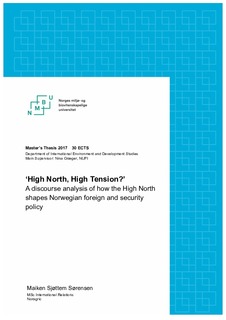| dc.description.abstract | The High North has been known as a low-tension area ever since the end of the Cold War, where actors have been able to cooperate despite other conflicts in the international sphere. However, geopolitical tensions are rising in the region, as military investments and exercises are increasing, dialogue among Arctic actors is ‘cooling down’ (especially between Russia and the West) and a growing number of external actors (such as China) are taking an interest in the region due to potential shorter transit routes and resources (fish, petroleum and minerals). Hence, a region known for low tension and cooperation appear to be in a state of change, where power politics and traditional security issues have re-emerged.
The aim of this thesis has been to investigate how the Norwegian High North discourse has developed over time to understand the political dynamics in the region, from a Norwegian perspective. The thesis sets out to supplement the already existing debate within International Relations. In order to operationalize the research questions, I have investigated historical Norwegian discourses on the High North, using discourse analysis as a method and theoretical approach. The main analysis is delimited to a twelve-year span from 2005 to 2017, with a focus on the first ten years. An introduction to discourses before, during and immediately after the Cold War is also provided.
It was found that 2005 marks a discursive shift in Norwegian High North discourse, which was the year the Norwegian Government coined the High North Norway’s most important foreign policy area. Since then, the region has taken a great share of Norway’s foreign policy discourse and debate. A mix of liberal and realpolitik narratives have constituted the High North discourse, where military presence, cooperation and dialogue are presumed to be vital to ensure Norwegian sovereignty and interests in the region. The discourse has also experienced a move between securitization and desecuritization, where the process of securitization is argued to reflect political tension or thaw. It was found that after Russia annexed Crimea (2014), the High North has become securitized, and the security and realpolitik discourses have become dominant in the discourse – even though the liberal narrative still has a central position within the discourse. This has proved to have constitutive effects, as Norway’s discourse seem to focus more on security and defence. The study has also revealed Russia’s crucial role in the Norwegian High North discourse, and that its relationship with the West affects Norwegian foreign and security policy in the region. | nb_NO |

